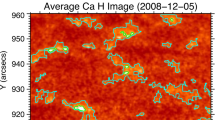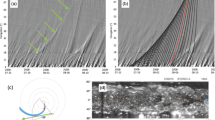Abstract
A time-lapse sequence of spectroheliograms in the bandhead of CN at λ3883 reveals the following behavior of the photospheric network with time:
-
(1)
There is a steady flow of bright ‘points’ (≃ 1000 km in diameter) laterally outward from sunspots at speeds on the order of 1 km·sec−1. After traveling about 10 000 km from a sunspot they either conglomerate to form fragments of the photospheric network or disappear.
-
(2)
Spatial changes in the network pattern seem to take place by means of the shifting of network fragments laterally on the solar surface. Although most small-scale details are recognizable after 5–10 minutes, within 30 minutes nearly all the details have changed completely. In contrast to this, the large-scale network pattern seems relatively unchanged after 2 1/2 hours.
-
(3)
Occasionally ‘new’ network, not resulting from the lateral motion of bright features from either previously existing network or sunspots, appears on the solar surface. This process consists of the formation in approximately 10 minutes of bright points and a darker-than-average feature between them. The dark feature disappears in another 5–10 minutes and the bright points separate at a relative speed of a few km·sec−1. If the event is of a sufficiently large magnitude, a sunspot will appear.
These observed changes of the photospheric network with time are interpreted as formation and motions of photospheric magnetic fields. It is suggested that these motions reflect the presence of both short-lived small-scale and long-lived large-scale photospheric currents such as one might expect from the granulation and the supergranulation.
Similar content being viewed by others
References
Chapman, G. A. and Sheeley, Jr., N. R.: 1968,Solar Phys. 5, 442.
Leighton, R. B., Noyes, R. W. and Simon, G. W.: 1962,Astrophys. J. 135, 474.
Leighton, R. B.: 1964,Astrophys. J. 140, 1547.
Livingston, W. C., Aikens, R. S., Doe, L. A. and Slaughter, C. D.: 1969, communication at the A.A.S. Special Meeting on Solar Astronomy, February 18–21, Pasadena, Calif.
Mayfield, E. B., Vrabec, D., Rogers, E., Janssens, T. and Becker, R. A.: 1969,Sky and Telescope 37, 208.
Minnaert, M., Mulders, G. F. W., and Houtgast, J.: 1940,Photometric Atlas of the Solar Spectrum from λ3612 to λ8771 (ed. by D. Schnabel/Kampert and Helm), Amsterdam.
Ramsey, H.: 1969, communication at the A.A.S. Special Meeting on Solar Astronomy, February 18–21, Pasadena, Calif.
Simon, G. W. and Leighton, R. B.: 1964,Astrophys. J. 140, 1120.
Author information
Authors and Affiliations
Additional information
Kitt Peak National Observatory Contribution No. 453.
Operated by the Association of Universities for Research in Astronomy, Inc., under contract with the National Science Foundation.
Rights and permissions
About this article
Cite this article
Sheeley, N.R. The evolution of the photospheric network. Sol Phys 9, 347–357 (1969). https://doi.org/10.1007/BF02391657
Received:
Issue Date:
DOI: https://doi.org/10.1007/BF02391657




